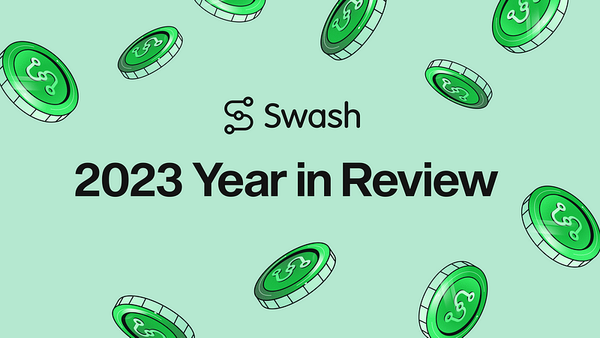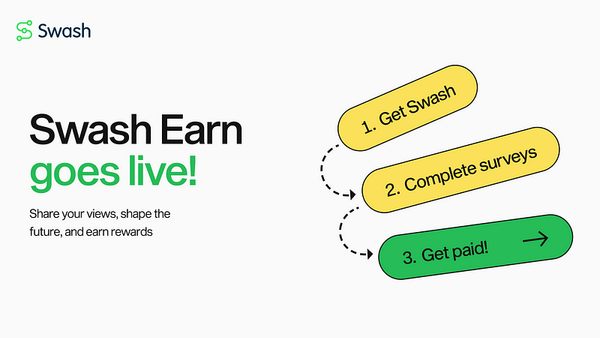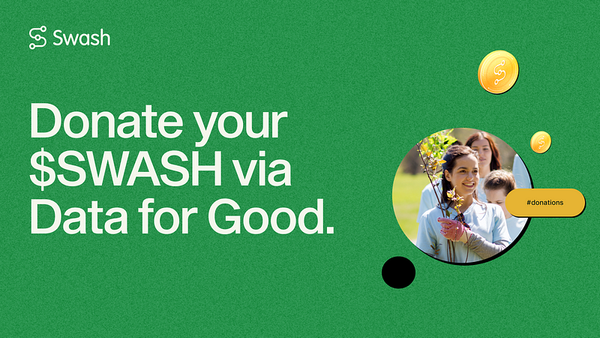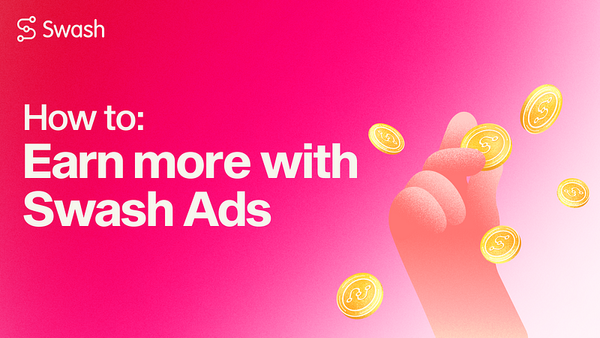AMA Recap: Swash meets AMA Lounge
This Wednesday, Swash was thrilled to join AMA Lounge, an engaged community wanting to learn more about crypto solutions, in an AMA on…
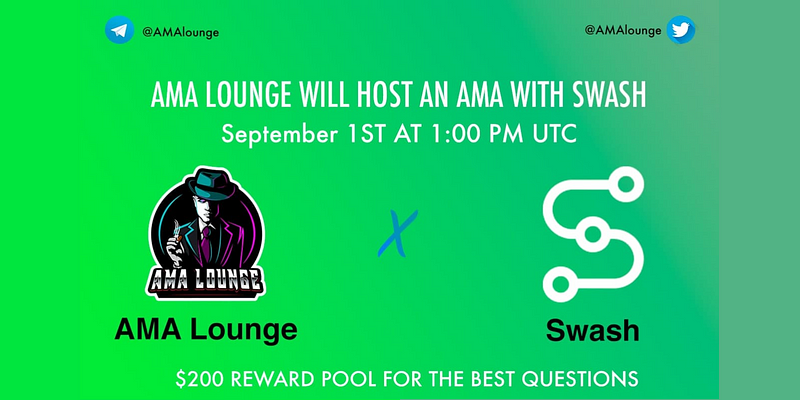
This Wednesday, Swash was thrilled to join AMA Lounge, an engaged community wanting to learn more about crypto solutions, in an AMA on their Telegram channel to unroll all the purposes of Swash.
The AMA Lounge community asked 70+ questions during the AMA, ranging from Swash’s revolutionary Wave Solutions to data privacy and ownership.
Keep reading for the full conversation.
What kind of a team do you have behind Swash? Some experts into cybersecurity, blockchain, etc, I assume?
Chloë:
Exactly. I’m really proud to be working with some of the best minds in Web 3! Our techies are all senior in their field and with strong academic backgrounds, and have been working for 10+ years in areas like cybersecurity, software dev, and blockchain across industries like banking, enterprise, research, and application security. The marketing and biz dev side of Swash also boasts diverse experience working in blockchain and with experience in both startups and corporates.
We also work with external teams of designers and lawyers and our expert advisors who support us in making sure Swash follows the tried-and-tested methods they’ve seen work — as many of them are Founders themselves, such as Bruce Pon from Ocean Protocol and Henri Pihkala from Streamr. Other advisors support us from a data privacy perspective too, so we have all angles covered.
That’s the key indeed, strong field-specific backgrounds. Really strong backing as well with the advisors including the CEO of one of my personal favorite projects.
Let’s get into Swash then. You shortly touched that a lot of cybersecurity people are involved but we’d love to hear more!
On what kind of things is Swash concentrating on? How do you actuate users to take part in the ecosystem and what’d be the core technologies behind Swash?
Chloë:
I think the easiest way to explain it would be to introduce you to what we call our “Key Principles”. These are:
- Incentivise: Provide a way for users to get paid for the value of their data and to put it to good use.
- Access: Improve access to high-quality, zero-party data for businesses and data scientists.
- Build: Encourage developers and entrepreneurs to join a new generation of data solutions.
- Collaborate: Work alongside ecosystem partners to allow for interoperability and mass adoption at scale.
So users — whether everyday people using the internet, businesses, or developers — are incentivised to use Swash and to participate in the ecosystem with different kinds of value; earning their share of the profits generated from data, getting access to high-quality, zero-party data, and having the environment and tools for building the next gen of solution
As for the core technologies, there’s a lot I could say here. They’re all outlined in our whitepaper. I like to approach talking about Swash tech by what potential it has, so the types of solutions that can be built on top of it
To be brief about those solutions (we call them ‘First Wave Solutions’) they include:
- Data Union: Optimising individual agency as a collective force by rewarding union members for the value of their data
- sIntelligence: Bringing unique insights to businesses across all industries through a customisable, comprehensive web-based platform
- sApps: Expanding the Swash ecosystem with the tools, community, and culture for building the next era of data solutions
- sCompute: Uniting innovation with access by making on-site data computation capabilities a reality.
So, basically we could monetise the data collected from us, right?
Chloë:
Yes, that’s correct. The Swash model is focused on redistributing the value of data back to the people who generated it.
A very trendy topic indeed, data rights!
How long have you been building Swash so far and do you perhaps have some existing user base for the product?
Chloë:
Swash launched about 2 years ago and the browser application currently has over 60,000 users! So this is the first (already live) Swash solution. It’s exciting to see the mission we’re working towards resonate with so many others. This is really just the beginning.
The timing fits rather well with the GDPR reform we had in Europe in summer 2018. Any idea if the idea of Swash rooted from that?
Chloë:
That’s a big part of it! Around that time we saw what I think will be considered landmarks in the history of data. Whether that’s GDPR or scandals like Cambridge Analytica — Facebook. Regardless, it certainly marked a shift in consciousness where people started to wake up to the fact that we deserve a say in what happens to our data
This has only continued to grow, especially with the massive digitisation we’ve seen over the last year… And the impending demise of third-party cookies!
Love that. Certainly a topic that I’m keen on — increasing the rights of data for the users themselves. GDPR isn’t even the only one, I believe there was CCPA in California around the same time.
Chloë:
Yes, that’s right. And I believe Brazil recently implemented something too. A lot of the legislation around the world is heavily based on GDPR.
Yeah, indeed — perhaps the next big thing after the current “NFT hype”. Something that’ll just grow over the years nevertheless, and gain more and more importance.
Chloë:
I think it’s also worth adding here that, unlike NFTs or even crypto in general, we all have data. It’s not only for a select few
So regarding the Swash App itself, I believe it currently operates as a browser plugin? Could you please tell a bit more about that? Which devices/browsers could we currently use it with?
Chloë:
Of course. Yes, it’s a browser plugin that’s available on all major browsers (including Brave). It’s only on the web for now, but we’re working on a mobile-friendly version. It takes just a few mins to install, during which we create a wallet for you, then you simply leave it to work in the background while you surf the web as normal.
Ah, gotcha. Something I wanted to ask actually — glad the installation process is so simple.
Does it use a lot of my device’s CPU by the way? Some plugins are really heavy on browsers so this question popped into my mind.
Also, what kind of data would the Swash App collect from its users? How would it handle the ‘more sensitive’ data such as passwords (seed phrases for us crypto fanatics), names or emails?
Chloë:
We haven’t received any reports of people having issues with this so far, with 60K+ people and 15 versions/updates later.
Swash simply doesn’t capture ‘sensitive’ data, it completely ignores it. The type of data it collects varies depending on different domains (all of which are outlined in the privacy policy you’ll see during the onboarding process). From Amazon, for example, it will capture things like searches, search results, whether an item is added to your basket or wishlist, that kind of thing. These domains are within categories, like News, Social, Shopping, etc and this list is constantly expanding.
Could we monetise basically anything that would be collected by the App, and who’d coordinate the buyers for that data (can we control that). Where’s the revenue coming to Swash itself?
Chloë:
Well, the monetisation happens on your behalf. How it currently works is you install the app, then the data is captured and uploaded to what we call the Data Union (Swash data set). When that data is purchased by data buyers, 70% of the profits are then redistributed back out to the members of that union. There will be various forms of this kind of model as we expand the Swash ecosystem though as it will depend on the type of app, for example.
Swash handles the buyers on your behalf! Most people don’t really know how the data economy works, and really we shouldn’t expect them to. As a union model, Swash works with the interests of its members. There will also be a Swash DAO in future.
Do you have some regulatory endorsements/assessments by the way regarding the transparency for these? Especially in the view of GDPR, CCPA reforms recently about data handling? A community-centric approach is always what we love here at AMA Lounge! 70% distributed to members!
Chloë:
Yes! Swash has completed a Data Protection Income Assessment (DPIA) for the Information Commissioner’s Office here in the UK. The DPIA is an essential part of UK GDPR.
As you mentioned, we’ve already seen what happens with centralised models. There’s no point in repeating that if we want to create something with longevity and value for everyone.
Web 3 and decentralisation are coming.
You also had quite a list of partnerships formed already to date — Ocean Protocol, Chainlink and Streamr popping to my eyes especially — a couple of them you actually mentioned to be your advisors as well. Would you like to enlighten us slightly further regarding these?
Chloë:
Sure. We actually released this blog just a few days ago about our partners and the work we do with them! We’ve been working closely with them, including working with them to develop code, plus integrating with their tech.
With Streamr, Swash will continue to utilise the Streamr network as the integration layer and the Streamr marketplace will be where Swash stream data is sold. They’ve been crucial for the emergence and growth of Swash from the beginning as we were inspired by their mission and built Swash as a result!
With Chainlink, we are integrating their oracle solution to make proportional revenue distribution and easy withdrawals for our members possible
With Ocean Protocol, Swash was one of their Day 1 Data Launch partners in Ocean Market, attracting over €300K of staked value in the Swash pool at its peak. We were also on their Shipyard program and will continue to work with them by integrating their Compute-to-Data with Swash’s sCompute.
Yeah, I thought you could be utilising Ocean Market for monetisation and beyond. You were also part of Streamr’s Stack from what I read. Great partners for sure, kind of pioneers within the field in blockchain!
Chloë:
Right! And we’re all driven by the same mission which makes working together that much more fulfilling.
Indeed, I see great things forming from this “alliance” in the future.
What kind of use cases is the $SWASH token serving for the ecosystem? From what I’ve read it’s also supporting rather many chains at once, at least later on. Why did you decide to go with the ERC-677 standard instead of the more adopted ERC-20 though when it comes to Ethereum?
Chloë:
The $SWASH token will be a utility and governance token and will be used within the ecosystem whenever a transaction takes place — whether through marketplaces or in products and services. It will also be the token people will receive as their earnings which they can use to either donate to social goods organisations, use to stake liquidity, or to redeem for other products. Holders will also have voting rights within the Swash DAO.
The reason we chose ERC677 instead of the ERC20 is because the ERC20 standard is not well designed for cases where a contract wants to complete some actions after receiving an ERC20 token. The ERC-677 proposes a solution for this by allowing users to send tokens to contracts and for the receiving contract to receive the tokens all in one transaction. This not only helps decrease transaction costs but also makes for better UX!
SWASH will originally be minted on Ethereum then bridged to other networks like BSC, xDai, Polygon
Seems quite all-inclusive as a whole and glad to see you’re involving the community with DAO mechanism as well! I’m not so familiar with the standard mechanisms themselves but it sounds like something that you’ve thought thoroughly about.
Glad to see so many decent EVM blockchains there, cross-chain is in my opinion a key thing in the future as well and you’re surely making the best out of it.
Before moving onto the community round I’d like to ask what kind of things would Swash App have on its roadmap for the upcoming months or so? How do you vision the data rights to develop for the users in the upcoming years?
Chloë:
The roadmap is primarily focused on our development milestones, which you can see here and more details in the whitepaper. The key developments are:
- Rise (Q3 2020 — Q1 2021) — Swash application growth
- Surf (Q3 2021- Q4 2021) — sIntelligence platform development
- Flow (Q4 2021 — Q3 2022) — sCompute and sChannel launch
- Surge (Q2 2022 — Q4 2022) — First sApp releases
- Onshore (Q1 2023 — Q3 2023) — sApp development and upgrades
- Swash (Q4 2023 — Q2 2024) — Swash smart contracts
I’m very optimistic about how data rights will develop! Swash isn’t alone in wanting to see positive change happen, and it’s all about people’s power. At this stage, I think a key hurdle is education as, like I mentioned, it’s not common knowledge that this is how the data economy currently works. Those conversations are usually quite doom-and-gloom. Now we can start saying “this is what’s happening and it’s not good for users, but look! Here’s an alternative! It doesn’t have to be this way!
Now, let’s start with the questions from the community.
Swash accumulates our data by running in the background while you surf the internet, where in exchange, we earn by it. But what specific data does Swash have access on? As it was running in the background, can it be restricted by a certain website like our online banks and our data would be an exception for that one?
Chloë:
Thanks for the question. The full breakdown of the data the Swash browser app collects can be found in the privacy policy within the extension itself. If you mean can Swash be restricted by certain sites, then no, but if you don’t want Swash to capture your data on certain sites, you can just switch the toggle off in the popup window. If the concern is around sensitive data on online banking websites, then that information is ignored by Swash.
In your website you stated being transparent and secure, and privacy is one major determinant when users use the web. How safe and convenient have you made it so that vital information that we enter in your website can’t be accessed by third parties or leaked to the public?
Chloë:
The first thing I would like to raise here is that the data being captured by Swash is being captured by others anyway — the difference is that Swash returns the value to you, rather than extracting it and reaping the benefits without you seeing a penny. Swash anonymises and end-to-end encrypts the data for added security, and the only identifier is your public wallet address to return your earnings to you, not any sensitive information that you’ve entered anywhere online (again, Swash doesn’t collect anything sensitive).
As user data is a serious thing in today’s world, only getting more essential day after day, it causes fear in users’ trust. It makes it more difficult to trust applications such as Swash since hackers are everywhere. How does Swash actually protect our data?
Chloë:
Good point! I find this a very interesting question actually, because a lot of people are dubious about solutions that are trying to create new power dynamics since we’re just not used to seeing it, especially if it sounds too good to be true. Swash returns value to people with a ‘better-than-free’ model, but it’s technically not ‘free money’ as it’s money that’s already out there (estimated to be trillions of dollars worth!).
I’ve addressed some of the security measures Swash has in place in the previous answer, but just to highlight that this data is being collected whenever we use the web and I’m pretty sure the majority of us have no idea what happens to it. Even if we did, we wouldn’t be able to do much about it. Swash is trying to change that by creating an ecosystem dynamic that puts the individual first, allowing for a symbiotic relationship between people, businesses, and developers, rather than continuing with the existing status quo that relies on more extractive and shady methods.
I read on your Twitter about the form of “Universal Basic Income.” Can you explain about this? and what are the benefits?
Chloë:
So the idea of Universal Basic Income is that everyone receives a certain income from their government or elsewhere without having to work (in the traditional sense of the word). Swash is rewarding people for what they already do when they surf the web, so there’s no need to change habits to ‘earn’. In that sense, it’s like a passive income source which will only become more valuable as the Data Union grows. More data = more value.
Security is the main concern for Investors. Before the launch have you completed any audits by 3rd party security farms? Did they find any issues?
Chloë:
Yes, CertiK conducted audits and found no issues.
What problems are Swash facing when trying to deploy Swash’s products in active businesses? What is difficult to explain to non-crypto users about Swash and what are the benefits of using it?
Chloë:
The only hurdle so far is the education around how data works/why it’s valuable and getting more people in the general public to understand it. Swash is designed to be as friendly to use as possible as we want to reach audiences beyond blockchain. That’s why things like setting up the wallet are done while onboarding. For the browser app, there will be a UX update coming soon and we’re always trying to improve so people who are less tech-savvy can participate and start reclaiming ownership over their data.
Swash is a great option because no matter what, your data is being sold anyway whenever you use the internet. What else is advantageous in Swash?
Chloë:
There are different benefits for each ecosystem actor:
For internet users:
- Regain ownership and receive passive income as they surf the web.
- Collectively invest value of data into social development.
- Exchange data value for alternative ecosystem benefits.
For businesses:
- Access high-quality, zero-party data at scale.
- Save time and money by eliminating intermediaries and reducing ad fraud and bots.
- Improve the reputation and sustainability of business practices.
For developers:
- Accelerate innovation due to improved access to diverse data.
- Be part of a new generation of data solutions.
- User acquisition through incentivisation mechanics and communication.
About Swash
Swash is an ecosystem of tools and services that enable people, businesses, and developers to unlock the latent value of data by pooling, securely sharing, and monetising its value.
People share their data to earn while retaining their privacy. Businesses access high-quality, zero-party data in a sustainable and compliant way. Developers set up and build systems within a collaborative development framework with ease.
Swash is reimagining data ownership by enabling all actors of the data economy to earn, access, build and collaborate in a liquid digital ecosystem for data.
Originally published at https://swashapp.io on September 2, 2021.


